Despite knowing it’s coming, aging in your 30s comes as a surprise to many women. Here are the steps for how to take care of your skin in your thirties.
If you’re in your 30s, you might have started to notice a few subtle changes in your skin. I know I sure have.
Maybe it’s not as smooth, firm, or radiant as it used to be. Maybe you’re seeing some fine lines, wrinkles, or dark spots.
All these changes have probably made you start to wonder what you can do to keep your skin healthy and youthful.
Don’t worry, you’re not alone. Your 30s are a time of transition for your skin.
It’s when your skin starts to show the effects of aging, sun exposure, stress, and environmental factors. It’s also when your skin needs some extra love and attention.
In this article, we’ll share some tips on how to take care of your skin in your 30s.
These tips will help you maintain and improve your skin’s appearance and function. They will also help you prevent or delay further signs of aging and damage.
In the end, you should be able to enjoy having beautiful, glowing skin in your 30s and beyond.
Sounds good? Great! Let’s dive right in, shall we?
This post may contain affiliate links.

Understanding Your Skin In Your 30s
As mentioned before, your 30s are a time of transition, especially for your skin.
Some of the skin changes that will occur over the next decade are:
- A decrease in collagen production: Collagen is the protein that gives your skin its structure and elasticity. As you age, your body produces less collagen, which leads to sagging, thinning, and wrinkling of the skin.
- The appearance of fine lines and wrinkles: The repetitive movements of your facial muscles, such as smiling, frowning, or squinting, create creases in your skin over time. These creases become more visible as your skin loses its firmness and moisture.
- Cellulite on arms: Cellulite is another skin transition you might experience stepping into your 30s.This is a common cosmetic condition characterized by the appearance of lumpy or dimpled skin. Hormonal changes, body fat distribution and collagen structure are the most common reasons of what causes cellulite on arms.
- Dark spots and uneven tone: Sun exposure is the main cause of hyperpigmentation, or darkening of certain areas of the skin. Sun damage accumulates over time and becomes more noticeable in your 30s. Hormonal changes, such as pregnancy or birth control pills, can also trigger melasma, a type of hyperpigmentation that affects the forehead, cheeks, and upper lip.
- Adult acne: Acne is not just a teenage problem. Many people experience breakouts in their 30s due to hormonal fluctuations, stress, diet, or skincare products. Adult acne tends to affect the lower face, such as the chin and jawline.
- Dryness and sensitivity: Your skin’s natural barrier function weakens as you age, making it more prone to losing moisture and becoming irritated by external factors. You may notice that your skin starts to feel tight, flaky, or itchy more often. An anti-aging cream can make a huge difference in the dryness of your skin.
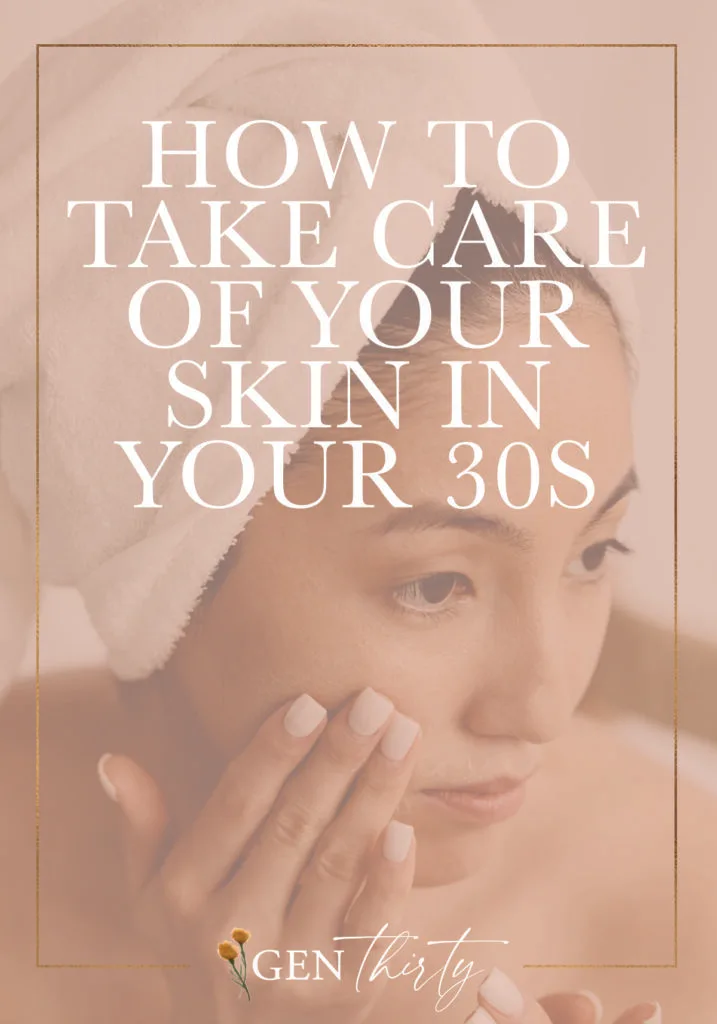
Your lifestyle choices also have a big impact on your skin health. For example:
- Diet: What you eat affects how your skin looks and feels. A balanced diet rich in antioxidants, vitamins, minerals, and healthy fats can help nourish and protect your skin from within.
- Stress: Stress can trigger a cascade of hormonal changes that affect your skin. Cortisol, the stress hormone, can increase oil production, inflammation, and blood sugar levels in your body. This can lead to acne breakouts, premature aging, and impaired wound healing.
- Sleep: Sleep is essential for your skin’s repair and regeneration. During sleep, your body produces growth hormone and melatonin, which help stimulate collagen synthesis and fight free radical damage. Lack of sleep can cause your skin to look dull, tired, puffy, and saggy.
According to a study by Olay, about 80% of women’s skin aging is due to external factors such as sun exposure and lifestyle habits. This means that you have a lot of control over how your skin ages.
The good news is that it’s never too late to start taking care of your skin.
By adopting a proper skincare routine and a healthy lifestyle in your 30s, you can prevent or delay further signs of aging and damage. You can also improve your skin’s appearance and function with some targeted treatments and products.
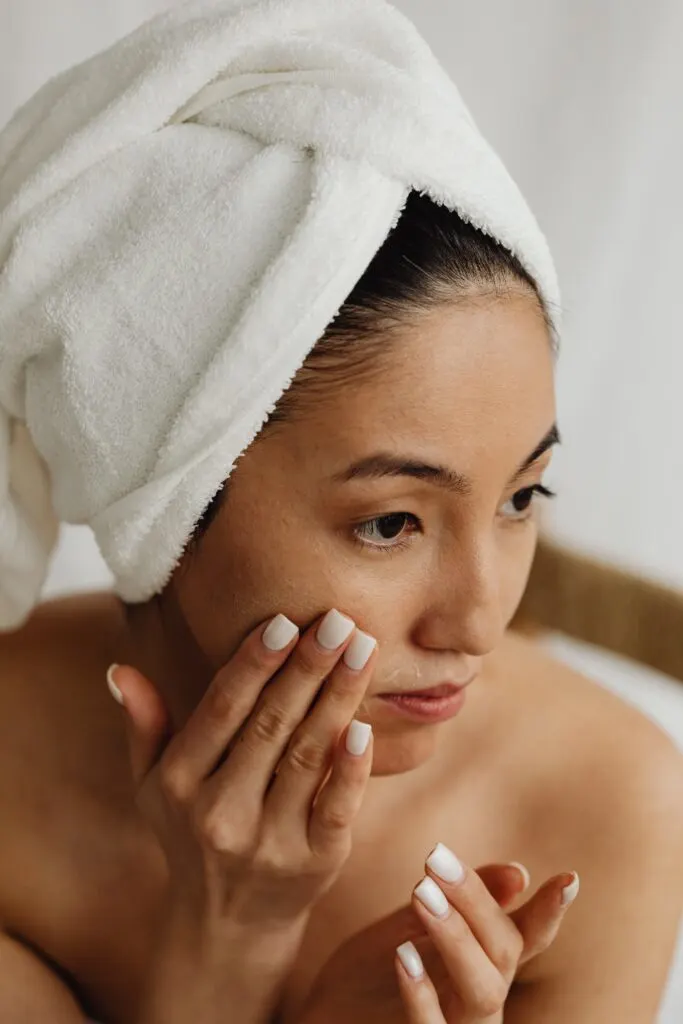
Daily Skincare Routine In Your 30s
A daily skincare routine is the foundation of healthy and beautiful skin.
In your 30s, your routine should focus on cleansing, moisturizing, and protecting your skin from the sun and other environmental aggressors.
Here are the steps you should follow every day for the best skincare routine to slow down the aging process:
Step 1: Cleanse your skin with a gentle cleanser that suits your skin type and concerns.
A cleanser should remove dirt, oil, makeup, and impurities without stripping your skin of its natural moisture.
You can use an oil cleanser or cleansing balm as a double cleanse step to remove extra makeup.
Look for cleansers that contain hydrating active ingredients such as glycerin, hyaluronic acid, or ceramides.
Recommendations:

Facial Soap Bar from Eco Roots: Handmade in small batches with organic ingredients, this facial soap is cleansing and hydrating.

Juneberry and Collagen Hydrating Cleanser: This creamy, hydrating cleanser gives skin a cooling sensation while it removes dirt and oil, exfoliates dryness, and moisturizes skin.
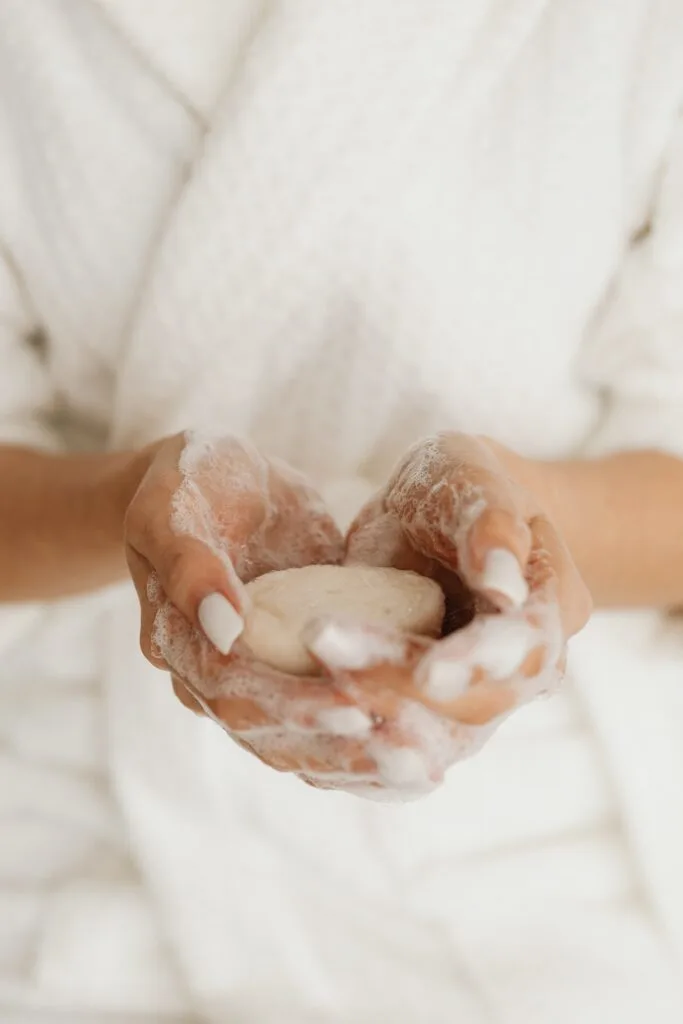
Step 2: Apply an antioxidant serum to your face and neck.
Antioxidants are molecules that neutralize free radicals, which are unstable atoms that cause oxidative stress and damage to your skin cells.
Antioxidants can help prevent and repair signs of aging, such as wrinkles, sagging, dry skin, and dark spots. They can also boost your skin’s brightness, firmness, and hydration.
Some of the most common antioxidants used in skincare are vitamin C, vitamin E, niacinamide, and green tea.
Recommendations:

Derma E Vitamin C Serum: This serum is designed to diminish the appearance of fine lines, wrinkles, uneven skin tone, and age spots.

Honest Beauty Antioxidant Serum: Get your daily dose of greens with this serum that works to improve the appearance of uneven skin tone as well as texture.

Versed Sunday Morning Antioxidant Oil-Serum: This antioxidant serum is an oil hybrid that works to strengthen the skin’s barrier, moisturize, and deliver an all-day glow.
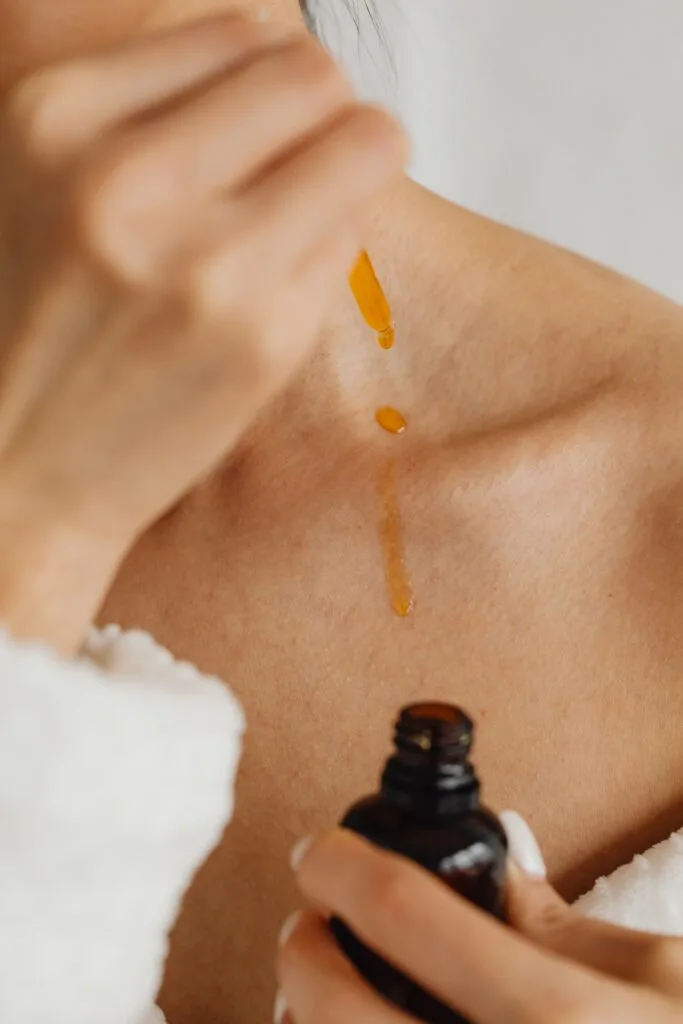
Step 3: Apply a moisturizer to your face and neck.
A moisturizer is essential to keep your skin hydrated, plump, and smooth.
It also helps strengthen your skin’s barrier function, which protects your skin from irritants and infections.
Recommendations:

Follain Moisturizer Replenish and Protect: This award-winning moisturizer is clinically proven to visibly smooth the look of fine lines and wrinkles and improve skin’s elasticity

Retinol and Collagen Cream for Face with Hyaluronic Acid: This is great for all skin types, including sensitive skin, that can benefit from the healing properties of nature while encouraging cell-turnover.

LAMARINE SKINCARE Moisturizing Cream: This moisturizer star marine ingredients like pearl powder and jelly fish extract to moisturize the skin, firm and smooth fine lines, and hide wrinkles.
For specific recommendations, read more at my post about the best moisturizers for your 30s. A night cream along with a neck is best to use at night to hydrate the skin.
You can also consider sleeping with a silk pillowcase to protect your skin even further.
Step 4: Apply a sunscreen with at least SPF 30 to your face and neck.
Sunscreen is the most important step in your skincare routine, as it protects your skin from the harmful effects of ultraviolet (UV) rays. UV rays can cause sunburns, premature aging, hyperpigmentation, and skin cancer. Sunscreen should be applied every day, regardless of the weather or season.
My favorite SPF is the Crunci Sunlight SPF. It blends seamlessly into the skin and looks beautiful under makeup.
UV damage is hard to reverse, so in this case, preventative care is the best step to take.
Addressing Specific Skin Concerns in Your 30s
Apart from following a daily skincare routine, you may also want to address some specific skin concerns that are common in your 30s. Here is how to do that:
Hyperpigmentation:
Hyperpigmentation is the darkening of certain areas of the skin due to excess melanin production.
It can be caused by sun exposure, hormonal changes, inflammation, or acne.
Use a gentle cleanser that contains salicylic acid or glycolic acid. And don’t forget to also use sunscreen every time you head out!
Recommendations:
- La Roche-Posay Effaclar Medicated Gel Cleanser
- L’Oréal Paris Revitalift Bright Reveal Brightening Daily Scrub Cleanser
Acne:
Acne is a condition that occurs when your pores become clogged with oil, dead skin cells, and bacteria.
It can cause pimples, blackheads, whiteheads, or cysts.
Acne can be triggered by hormonal fluctuations, stress, diet, or skincare products. Use a topical treatment that contains ingredients that can lighten hyperpigmentation and treat acne.
Recommendations:
Eye Wrinkles
Use an eye cream to address the delicate area around your eyes. The skin around your eyes is thinner and more prone to dryness, fine lines, dark circles, and puffiness than the rest of your face.
An eye cream can help hydrate, nourish, brighten, and firm this area.
Recommendations:
- RoC Retinol Correxion Eye Cream
- Ole Henriksen Banana Bright Eye Crème
- 15 Best Eye Creams For Your 30s
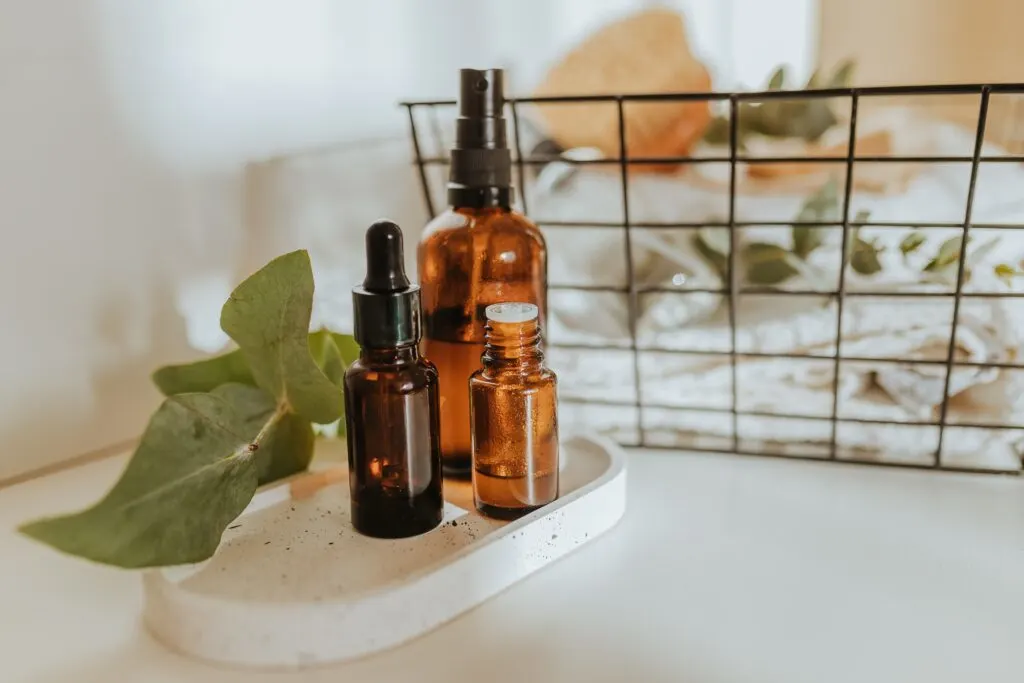
Professional Treatments and Procedures
Besides using skincare products at home, you may also want to consider getting some professional treatments and procedures that can benefit your skin in your 30s.
Consider getting professional treatments that can improve your skin’s appearance and function. Some of these treatments are chemical peels (with key ingredients of chemical exfoliants like AHAs – alpha hydroxy acidws), laser peels, microdermabrasion, or microneedling.
These treatments can help remove the damaged layer of skin and stimulate the growth of new and healthy skin cells. Consult with your dermatologist before getting any of these treatments.
These treatments and procedures can help address specific skin concerns that you may have. Some of the most popular ones are:
Chemical peels:
Chemical peels are treatments that use acidic solutions to remove the outer layer of skin and reveal a smoother and brighter complexion. These can help treat hyperpigmentation, acne, fine lines, and dullness.
There are different types of chemical peels, ranging from mild to deep, depending on the strength and depth of the solution.
Mild peels can be done at home or by an aesthetician, while deeper peels require a dermatologist or a plastic surgeon.
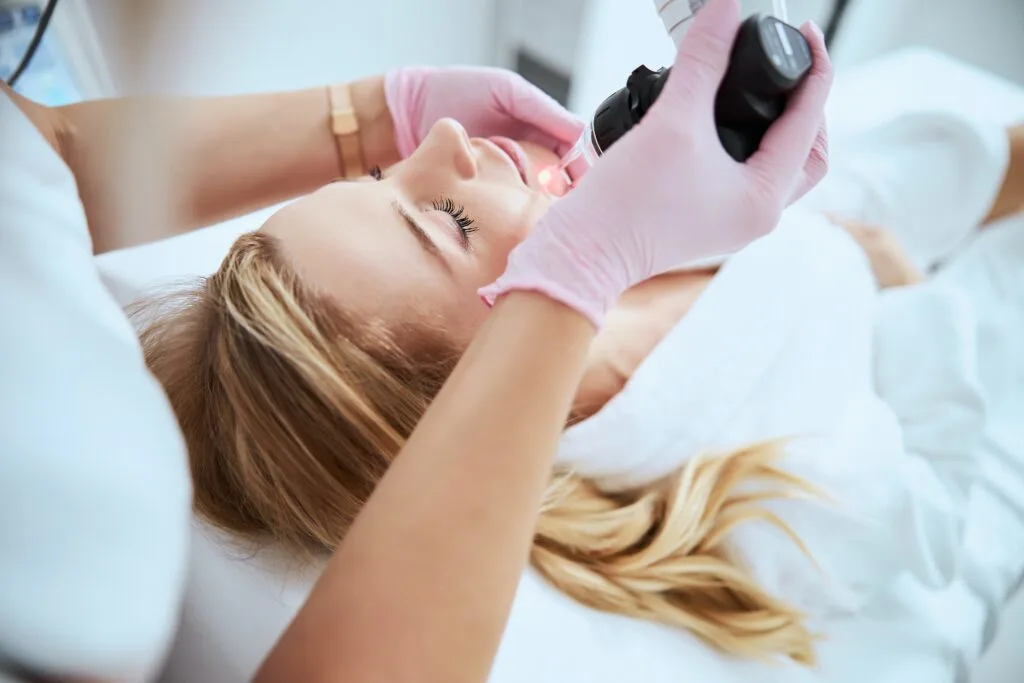
Injectables:
Injectables are substances that are injected into the skin to achieve various cosmetic effects.
There are two main types of injectables: neuromodulators and fillers.
Neuromodulators, such as botox work by temporarily paralyzing the muscles that cause wrinkles. They can help smooth out expression lines, such as crow’s feet, forehead lines, or frown lines.
Fillers, such as sculptra work by adding volume and plumping up the skin. They can help fill in deeper wrinkles, such as nasolabial folds or marionette lines. They can also enhance facial features, such as lips, cheeks, or chin.
Laser peels:
Laser peels are treatments that use laser beams to vaporize the outer layer of skin and stimulate the growth of new skin cells.
This procedure can help treat hyperpigmentation, acne scars, fine lines, and uneven texture.
There are different types of laser peels, ranging from ablative to non-ablative, depending on the intensity and depth of the laser.
Ablative lasers remove more skin tissue and require more downtime, while non-ablative lasers leave the skin intact and require less downtime.
Microneedling:
Microneedling is a treatment that uses tiny needles to create micro-injuries in the skin and trigger its natural healing process.
This treatment can help boost collagen production, improve skin texture and tone, reduce pore size, and fade scars and hyperpigmentation.
This procedure can be done at home with a dermaroller or by a professional with a dermapen or a dermastamp.
Lifestyle Choices For Healthy Skin
Here are a few healthy habits that you can adopt to support your skin health and well-being:
- Eat a balanced diet: Your diet can influence your skin health from the inside out. Eating a variety of foods that are rich in antioxidants, vitamins, minerals, and healthy fats can help nourish and protect your skin from oxidative stress and inflammation.
- Drink plenty of water: Water is essential for your skin’s hydration and function. It helps flush out toxins from your body and maintain your skin’s elasticity and plumpness. Drinking enough water can also prevent your skin from becoming dry, dull, or flaky.
- Exercise regularly: Exercise is beneficial for your skin health in many ways. It can improve your blood circulation and oxygen delivery to your skin cells. This can help your skin glow and heal faster. It can also reduce stress hormones and increase endorphins in your body. This can help improve your mood and prevent stress-related breakouts or flare-ups. Plus, exercise can also help you maintain a healthy weight and body shape. This can prevent sagging or stretching of your skin due to weight fluctuations.
- Manage your stress: Stress can have a negative impact on your skin health in many ways. It can trigger hormonal changes that can cause acne breakouts or exacerbate existing skin conditions. Stress can also impair your skin’s barrier function and make it more prone to infection or irritation.
- Get enough sleep: Sleep is vital for your skin’s repair and regeneration. During sleep, your body produces growth hormones and melatonin that help stimulate collagen synthesis and fight free radical damage. Sleep also helps balance your hormones and reduce inflammation in your body. Lack of sleep can cause your skin to look dull, tired, puffy, or saggy.
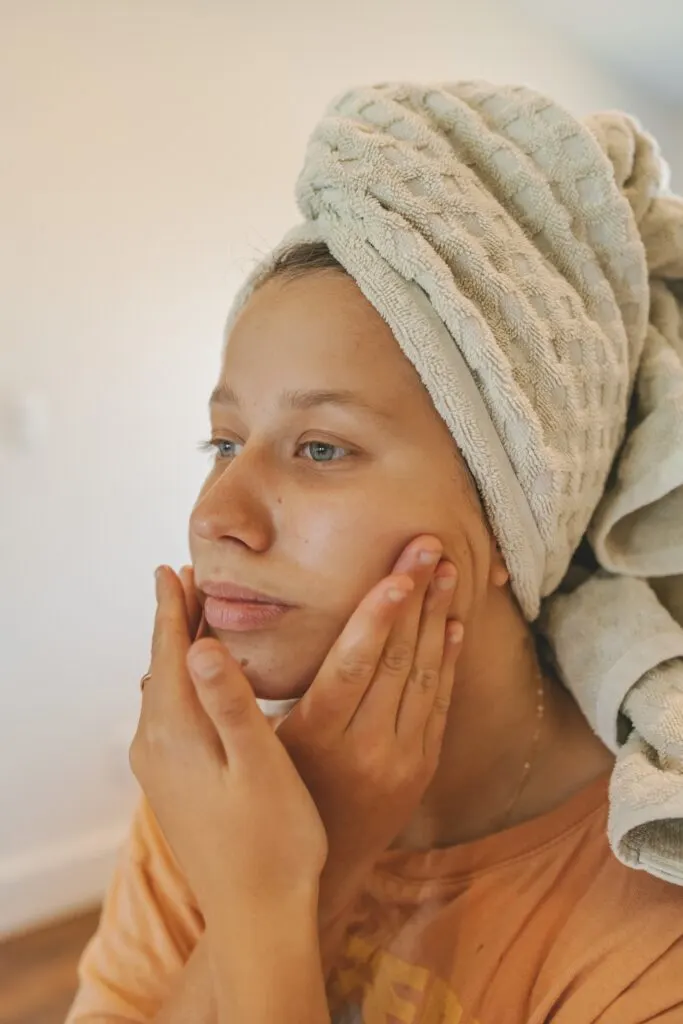
Final Thoughts on How To Take Care Of Your Skin In Your 30s
In your 30s, your skin will begin to show the effects of aging, sun exposure, stress, and environmental factors. This means you have just entered the period of your life where your skin needs some extra love and attention.
Remember, your skin’s health is influenced by your overall health and well-being. Therefore, you should also adopt some lifestyle changes that can support your skin health, including:
- Drink plenty of water to keep your skin hydrated and flush out toxins.
- Eat a balanced diet rich in fruits, vegetables, whole grains, lean proteins, and healthy fats. Avoid foods that are high in sugar, refined carbs, processed foods, and alcohol.
- Manage your stress levels by practicing relaxation techniques such as meditation, yoga, breathing exercises, or hobbies.
- Get enough sleep to allow your skin to repair and regenerate.
- Avoid smoking and limit your caffeine intake as they can dehydrate and age your skin.
The key to maintaining healthy and beautiful skin in your 30s is prevention and early intervention.
By following a proper skincare routine and a healthy lifestyle, you can prevent or delay further signs of aging and damage.
You can also improve your skin’s appearance and function with some targeted treatments and products.
However, remember that everyone’s skin is different and has different needs and goals. Your skin’s need can vary based on the season even. A good skincare routine is reactive to your skins needs.
Therefore, consider speaking with your dermatologist about your individual skincare concerns and treatment options.
At the end of the day, while taking care of your skin in your 30s may seem daunting, it doesn’t have to be.
With some knowledge and care, you can enjoy having beautiful, glowing skin in your 30s and beyond. Good luck!

